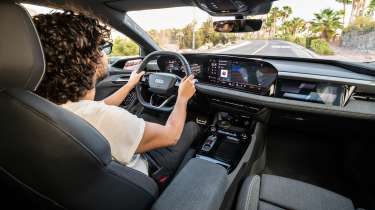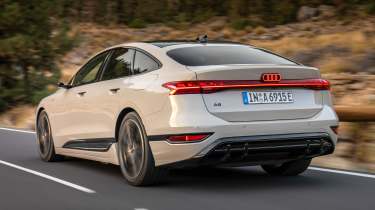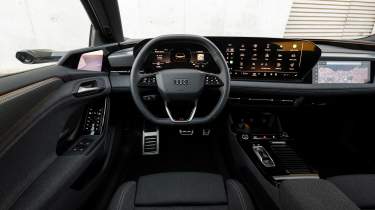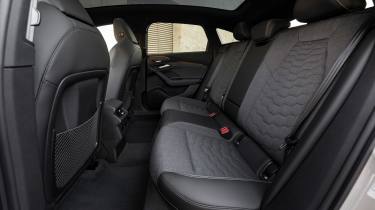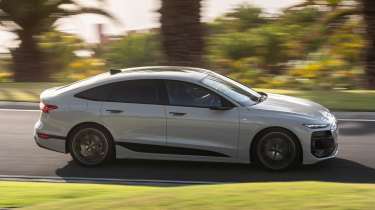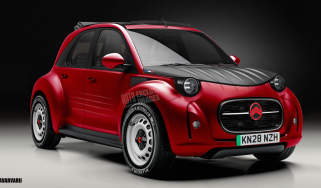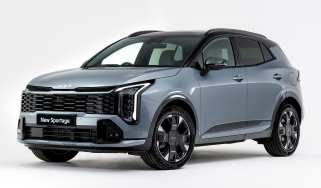Audi A6 e-tron review
The superb Audi A6 e-tron has a wide array of appealing attributes, making it arguably the best executive EV from the brand to date

Is the Audi A6 e-tron a good car?
Audi took its time getting an all-electric executive car together, but the wait seems to have been worth it. This sleek, comfortable, refined, and tech-filled model hits all the right notes – tight rear seats notwithstanding. Of more importance, though, is that it achieves some very impressive range and efficiency numbers. The fact it is also available in a more practical estate (or Avant in Audi-speak) is good news for those seeking extra space, but in a more aerodynamic package than an SUV.
| Key specs | |
| Fuel type | Electric |
| Body style | Executive saloon, estate |
| Powertrain(s) | 83kWh battery, 1x e-motor, rear-wheel drive 100kWh battery, 2x e-motors, four-wheel drive |
| Safety | 5-stars (Euro NCAP, 2025) |
| Warranty | 3yrs/60,000 miles |
How much does the Audi A6 e-tron cost?
Audi no longer has any excuses when it comes to its electric cars. First came the Audi e-tron, a compromised SUV based on an ICE platform, then the Audi Q4 e-tron and Audi e-tron GT arrived with underpinnings borrowed from elsewhere in the Volkswagen Group. It’s taken until now for Audi to produce a ground-up EV based on its own PPE platform, and on first impression, it's worth the wait.
Admittedly, we’ve already seen a couple of cars on this platform – the Porsche Macan Electric and Audi Q6 e-tron – but this A6 e-tron is arguably more interesting. Not only does it offer an alternative to the ubiquitous SUV body style, but it’s also the first all-electric replacement of a traditional Audi ICE model that won’t see a direct successor. For petrol fans, a new petrol-powered Audi A7 is on the way, but Audi is betting on this new electric A6 being its big seller, in both Sportback and Avant forms.
Used - available now
The A6 range is logically arranged around three powertrains and three trim levels, with prices ranging between £62,500 and £83,500. You’ll need to factor in an additional £1,800 for the Avant estate, while there’s also a range-topping S6 for £97,500. These all sound like big numbers, and they are, but when up against key rivals from BMW and Mercedes, the Audi doesn’t just undercut them all on price, it also offers some pretty hefty gains in efficiency, range and standard kit as well.
Engines, performance & drive
| Model | Power | 0-62mph | Top speed |
| Audi A6 e-tron | 282bhp | 7.0 seconds | 130 mph |
| Audi A6 e-tron Performance | 374bhp | 5.4 seconds | 130 mph |
| Audi A6 e-tron Quattro | 442bhp | 4.7 seconds | 130 mph |
To understand the A6 e-tron, one first has to understand the bits that go underneath it. The PPE platform constitutes Audi’s first in-house electric car chassis programme, which was co-developed with Porsche. As a result, not only is much of the architecture shared with the Q6 e-tron, but also the Porsche Macan and forthcoming electric Porsche Cayenne. There are pros and cons to such an arrangement, but luckily for Audi, the A6 has much to be positive about, starting with the powertrains and the driving experience.
Entry-level models have an 83kWh battery and a single, rear-mounted e-motor that produces 321bhp and 423Nm of torque. This will get the A6 from 0-62mph in six seconds flat using launch control (seven seconds without), seeing it top out at a limited 130mph. But the trick Audi has pulled here is to deliver a very impressive range of up to 383 miles on a charge, despite the moderately sized battery, and charging speeds capped at 225kW to help reduce top-up times on longer drives.
Next up is the ‘Performance’ powertrain, which retains a single motor layout but ups the power to 374bhp and torque to 565Nm. The 0-62mph time drops to 5.4 seconds, but the larger 100kWh battery pack offers a WLTP combined range of 463 miles, plus an impressive 270kW charging rate.
At the top of the A6 line-up is the dual-motor Quattro variant, with 455bhp and 580Nm of torque, dropping the 0-62mph time to just 4.5 seconds using launch control (4.7 seconds without). This also features the 100kWh battery and 270kW charging, but the heavier dual-motor set-up means a reduced range of 438 miles compared with the Performance model.
Beyond pure numbers, though, you can tell there’s some real class to the A6’s chassis. It’s a big car, but there’s depth to its engineering, because every aspect of the driving experience feels resolved and well considered. The steering is accurate and sharp, while the brakes have very good feel, with a seamless transition between the powerful regen and friction braking methods. Refinement is also top-notch, with minimal road noise and an effortless gait to the suspension; our car rode well despite being fitted with the largest 21-inch wheels.
What the A6 is not, though, is cumbersome to drive or contrived like some of its key rivals. It’s around 165kg lighter than an equivalent Mercedes EQE with a similarly sized battery, and matches the weight of a BMW i5 despite having a significantly larger battery capacity. As such, Audi hasn’t really bothered with chassis additions such as rear-wheel steering or active anti-roll systems, which not only promotes a natural driving experience, but also reduces weight in the process. The A6 e-tron is a car that feels designed from the outset to handle its inherent mass, rather than scrambling to find solutions to hide it.
Range, charging & running costs
| Model | Battery size | Range | Insurance group |
| Audi A6 e-tron Sport | 83kWh | 384 miles | 43 |
| Audi A6 e-tron Sport Performance | 100kWh | 463 miles | 44 |
| Audi A6 e-tron Sport Quattro | 100kWh | 438 miles | 48 |
The A6 we drove on test was the Performance model that engineers are arguably most excited about, due largely to the huge range figure that’s, literally, miles ahead of its key rivals from BMW and Mercedes. This 463-mile figure is derived from both the 100kWh battery pack and the fact that it is also more efficient than its main competitors, with an on-paper rating of 4.4m/kWh.
We achieved around 3.9m/kWh, which was very impressive, considering the hilly terrain on our test route and the large 21-inch wheels on our cars, which have greater rolling resistance than smaller wheel sizes.
For context, a close rival to our A6 Performance S-Line is BMW’s i5 40e M Sport, which costs more, at around £74,000, has slightly less power, at 335bhp, but has a 110-mile deficit in EV range, achieving at most 351 miles on the WLTP cycle.
The Audi is also ahead of the 428 miles that a Mercedes EQE350+ AMG-Line is claimed to be capable of; and if you’re tempted by the larger 21-inch wheels on the Merc, they’ll cost you another 50 miles of range on paper.
You'll also find that the A6 e-tron should hold on to its value better than its i5 and EQE rivals. According to our expert data, after a typical ownership period of three years or 36,000 miles, the A6 e-tron Sportback and Avant will retain between 49 and 56 per cent of their original value. In contrast, the BMW i5 saloon and Touring range maintain between 44 and 52 per cent over the same period, while the Mercedes EQE is only predicted to be worth between 36 and 42 per cent of its original value.
Insurance costs for the A6 e-tron will be similar to those of its i5 rival, starting in group 43 for the rear-wheel drive Sport, rising to group 50 for the high-performance S6 model.
Design, interior & technology
Regardless of colour choice, wheel design or whether you’re looking at the Sportback or less rakish Avant, the A6 e-tron is a striking car. There’s a lot to take in, as the design is fairly complex, yet also slightly generic at the same time.
Audi’s designers have done well to try to hide the PPE platform’s inherently high floor through the use of over-scaled graphics along the car’s lower flanks, and the super slim windows and lights do help the overall design look very sleek. However, it doesn’t exactly scream Audi.
All UK models will ride on at least 20-inch wheels, which helps to balance the design, and while we have lamented oversized grilles in the past, the A6’s body-coloured ‘grille shield’ graphic does look a little overwhelmed by the massive black mask that sits around it, especially in lighter colours.
The interior, which has typically been a high point for an Audi on executive models, is also complex thanks to an array of different materials, shapes and colours that seem crammed into a relatively small space.
The dashboard architecture is dominated by a massive curved dual-screen display that sits right at the top. Yet no matter your driving position, it never rises above the windscreen base, and thanks to the curve, everything is within easy reach.
This cliff of high-gloss display can initially be a little intimidating, but the clean, largely minimal graphics help to reduce the amount of visual clutter, with varying levels of success. A bigger issue is that this screen sits in what is itself a fairly complex interior, with many different layers of materials and interacting shapes that are a world away from the simple forms we’re used to in high-end Audis.
There are a lot of glossy black elements, especially around the centre console, but this is offset by plenty of other nice materials regardless of whether you’ve chosen the standard synthetic leather, high-quality full-leather upgrade or full-fabric options.
Key controls are still easy to access, though, with a volume knob, constantly visible temperature controls on-screen, and even a physical button to deselect the lane-keep assist all falling to hand. There’s also a bank of secondary switchgear on the door panel that resembles a TV remote that controls the lights, mirrors, windows and door locks. While it initially looks a little complicated, it doesn’t take long to master and brings all these elements out on a touchscreen.
Sat-nav, stereo and infotainment
That bank of screens is made up of a 14.5-inch main touchscreen and an 11.9-inch driver’s display which have the same resolution and brightness, helping them feel like one seamless interface.
They do need some navigating to get to know, but it’s easy enough to shortcut to common functions, such as disabling various driver aids or programming the embedded sat-nav.
However, the main menu system arguably lacks a little bit of hierarchy, as more and less important features are quite difficult to distinguish between, especially given the monochrome icons.
On the plus side, response, feedback and consistency are all good, if not quite at Tesla levels of crispness, and it doesn’t take long to understand how the navigation system, radio, climate or online services work, plus they all feel intuitive when in use. Climate functions are all controlled on the screen, but it’s big enough to house a dedicated bar on any menu for key functions such as temperature or fan speed.
It can be a little tricky for passengers to access the screen due to its curve towards the driver, but high-spec models have a third passenger display that alleviates this issue. However, while it is a useful addition, you can’t access Apple CarPlay or Android Auto on it, stunting its integration somewhat. If you stick to the main Audi interface, though, it is undeniably useful, allowing passengers to change radio stations or input new destinations into the nav without disrupting the main displays for the driver.
Those who want the high-end Bang & Olufsen stereo and head-up display will need to plump for the optional Sound and Vision Pack for around £3,000. This comes with a few other goodies, including the full ambient lighting upgrade and higher-spec USB-C charge points thrown in.
Boot space, comfort & practicality
| Dimensions | |
| Length | 4,928mm |
| Width | 2,137mm (inc mirrors) |
| Height | 1,455mm (1,493mm Avant) |
| Number of seats | Five |
| Boot space | 502-1,330 litres (502-1,422 litres Avant) |
There is one big problem to contend with, though, and that’s cabin space. In order to fit the batteries, the cabin floor is quite high, and the rear bench feels quite cramped as a result. This is compounded by the sloping roofline and dark headlining, but the optional glass roof and light interior trim options can help.
However, it’s nowhere near as spacious back there as the old A6 nor its modern electric rivals, although things do get better on the Avant. This could be a serious compromise if you require generous levels of second-row accommodation.
Interior storage is also fairly good, with a decent-sized glovebox and centre console, but the door bins are too small for larger bottles. The boot space is much better, at 502 litres, and there’s also a very handy underbonnet area of 27 litres to store your inevitably grubby charge cables, but this isn’t the most practical option in the class. Remarkably, both the Sportback and Avant have the same boot capacity with the seats up. However, the estate has the edge over the regular hatchback when the 40/20/40 split folding rear seats are down, increasing the boot capacity from 1,330 litres to 1,422 litres.
Safety & reliability
| Key standard safety features | Euro NCAP safety ratings |
|
|
Audi has acquired a comprehensive safety record over the years, and the A6 e-tron is no exception. It received a maximum five-star rating from Euro NCAP when tested in 2025. It could have done better in the vulnerable road user category, because not every model comes with a safety system that prevents occupants from opening the doors into the path of approaching cyclists or motorbikes.
As a brand new model, there’s not a huge amount of data to go on when it comes to reliability, and given that it uses a fresh platform, there could be one or two teething issues. However, lessons learned from the rollout of other VW Group models should help iron out any problems.
Like other electric models in the Volkswagen and Audi ranges, servicing is only required every two years, regardless of the mileage covered. That puts the A6 e-tron at a significant advantage for high-mileage users compared with the Mercedes EQE, which requires trips to the dealer every 12 months or 15,500 miles for routine servicing.
Audi A6 e-tron alternatives
This is where things get interesting for the A6 e-tron, because if you’re looking for an electric executive saloon there are obvious alternatives, but none is perfect by any stretch. The most obvious rival is the BMW i5. BMW’s decision to jointly develop its EV and ICE models on the one platform in this current generation means that, on paper, the BMW could be considered a compromise, and in some ways it is.
An i5 in its 40e configuration is around the same price as an equivalent A6 e-tron, but it delivers far less range due to its poorer efficiency and smaller battery. However, the i5 has somehow been able to eke out far more interior space than the A6, especially in the rear, which could be a deciding factor for some. In terms of the driving experience, the i5 is perhaps a touch more refined and variable, but it’s still a big and heavy beast, and ride quality on bigger wheels won’t be to all tastes.
Another rival is the Mercedes EQE, which also offers significantly more space in the second row than the Audi, but from here things go rather downhill. Thanks to a recent round of upgrades, the EQE 350+ gets close to the big-battery A6 with a range of 426 miles, but fitting bigger wheels reduces the overall range by around 50 miles. We’ve also found that the Mercedes is very sensitive to driving style and temperature, and has often struggled to match the efficiency ratings required to get anywhere close to its WLTP range figure.
The EQE’s biggest issue, though, is that it’s disappointing to drive, with little to no enjoyment to be had from behind the wheel – indeed, it’s actually quite unpleasant. Yes, it’s quiet and rides well on small wheels, but we would struggle to recommend one, even with its recent updates.
So while the A6 e-tron isn’t perfect, it is a very welcome return to form for the German brand. While it can’t match previous Audis in the historically strong areas of sleek, minimalist exterior design, a cleverly packaged interior or charismatic engines, it fights back with class-leading range, a comfortable driving experience and unbeatable value, which should have its rivals worried. Unless you regularly need to transport six-foot-tall passengers, the A6 is easily the pick of the rapidly improving electric executive saloon bunch.
Frequently Asked Questions
Three years or 60,000 miles, with the option of an additional two years.





